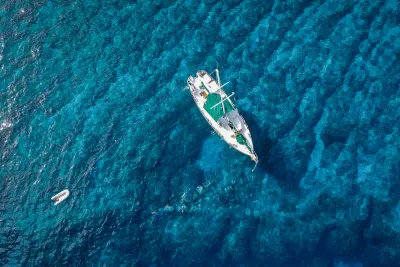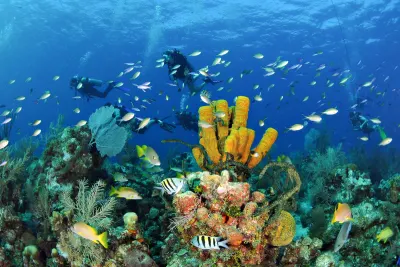With so many islands, atolls, and cays surrounded by beautiful seas, it’s no surprise that the Caribbean has plenty to offer when it comes to incredible watersports such as sailing, fishing, and more. But, this iconic region is also a hotspot for one-of-a-kind experiences that you don’t have to be qualified as a diver to enjoy – from swimming with sharks, stingrays and pigs, to accessible wrecks with a scandalous history.
So, whether you’re a non-diver looking to take to the seas or a scuba enthusiast wanting to fill some time during a surface interval, the Caribbean has tons of once-in-a-lifetime activities for you to enjoy.
Keep reading to discover the best snorkelling and swimming experiences in the Caribbean.
Whale sharks of Holbox and Contoy, Mexico

Located at the northeast tip of Mexico’s Yucatan Peninsula, not far from Cancun and Isla Mujeres, Holbox and Contoy are home to arguably the most sought-after snorkelling experience in the entire Caribbean. Each year, between the months of March and May, these small islands welcome one of the largest seasonal whale shark aggregations on the planet, giving visitors a chance to get up close and personal with the ocean’s biggest fish. Day trips depart from popular tourist hotspots such as Cancun and Isla Mujeres, making it easy to witness this jaw-dropping phenomenon, and strict environmental protections are in place to ensure interactions are as sustainable as possible.
MUSA, Mexico
Located along Mexico’s Caribbean coast, the Museo Subacuático de Arte – known as MUSA – is the world's largest underwater museum. Starting life in 2009, the project has now spread over three locations with the original, iconic sculptures located on Manchones Reef, off the southwest coast of Isla Mujeres. With a maximum depth of around eight-metres and fantastic visibility, MUSA represents a magical underwater experience for snorkelers and divers alike. In total, this remarkable underwater gallery features over 500 submerged sculptures, the majority of which were crafted by British sculptor, Jason DeCaires Taylor – including the world-famous art piece known as Silent Evolution.
Dreaming of your next holiday in the Caribbean?
Start planning, contact one of our dive travel experts today

ZuBlu is the leading dive travel agency to search, compare and book scuba diving travel worldwide.
Shark Ray Alley, Belize

Shark Ray Alley is situated close to the barrier reef off the south coast of Ambergris Caye, just a couple of kilometres from the Hol Chan Marine Reserve. Once used by fishermen as a convenient place to clean their catch, the sound of boats arriving at this expansive sand flat continues to attract large numbers of nurse sharks and Southern stingrays in search of an easy meal – hence the name, Shark Ray Alley. Visitors can enter the water amongst dozens of these docile creatures, often joined by vast schools of bait fish, and swim or snorkel amongst the throng of activity.
Stingray City, Grand Cayman

Located off the western corner of Grand Cayman’s North Sound, Stingray City is one of the Cayman Islands’ marquee underwater attractions. For many years, returning fishermen used to clean their catch around this shallow, sheltered sandbank and the local stingray population soon learnt to gather beneath the boats in anticipation of a snack. Both the site of Stingray City, and the rays themselves, are now protected, but divers and snorkelers are still allowed to enter the water amongst scores of these sizable rays, with most of the tourist action occurring in water no more than waist deep.
White Sand Ridge, the Bahamas

White Sand Ridge is a superb snorkelling spot situated more than 50-kilometres off the northern coast of West End, Grand Bahama. This isolated location places it beyond the reach of diving day trips and firmly in the realm of liveaboard excursions, reducing the possibility of crowds. This remote sandbank is a calving area for Atlantic spotted dolphins and frequently blesses visitors with one-of-a-kind wild dolphin encounters as a result. And, while Atlantic spotted dolphins are certainly the most common species found here, snorkelers are also sometimes joined by playful bottlenose dolphins too.
Pablo Escobar’s plane, the Bahamas
Norman’s Cay is a backwater spot in the Bahamas, located towards the northern end of the long Exumas island chain. The cay’s seclusion was likely one of the key attributes that caught the eye of infamous drug smuggler, Pablo Escobar, who’s cartel used Norman’s Cay as a refuelling stop during flights to the US. Today, in the shallow sand banks just off this small island, lies a sunken WWII-era military transport plane that was supposedly once part of the cartel’s extensive drug smuggling operations. Protruding from the water in places, this plane is easily accessible by snorkelers and provides some novel photo opportunities.
Swimming pigs, the Bahamas

This is easily one of the island’s iconic experiences and normally sits high on the bucket-list of visitors. The Bahamas’ world-renowned Pig Beach is located on the uninhabited island of Big Major Cay, within the Exumas. Interestingly, the pigs are not native to the island – having likely been placed there by farmers or sailors, or even washed ashore after a shipwreck – though they have certainly made themselves at home. Today, around 20 individuals reside here and seem to enjoy lounging on the beach, swimming in the shallows, and interacting amicably with lucky tourists in exchange for a snack or two tossed into the water.
Humpback snorkelling, Turks and Caicos
While plenty of places around the world host migratory humpbacks, few can promise the reliable sightings that Grand Turk and nearby Salt Cay are famous for. Each year between December and March, whale watching takes centre stage, as these gentle ocean giants make their way south to the Dominican Republic – where they’ll spend the summer breeding and calving. And you don’t just have to watch from the boat, because snorkelling with the whales is also permitted, so long as visitors follow strict environmental protocols. While these in-water encounters are never guaranteed, many operators stay poised to provide the option should an opportunity arise.
Humpback snorkelling, Dominican Republic

The humpbacks passing through the Turks and Caicos are on their way to a remote and shallow shoal within the Dominican Republic’s Sanctuary for Marine Mammals. Known as the Silver Bank, this isolated plateau plays host to one of the most significant whale migrations on the planet, with upwards of 5,000 humpbacks visiting the area each year. This far-flung destination can only be accessed via a liveaboard, but is well worth the extra effort, providing opportunities to witness an array of interesting behaviours as the humpbacks nurture new-born calves or seek out a mate.
Stingray City, Antigua
As the name suggests, this is another laid-back stingray experience located on the outer reefs of Antigua’s northeast coast, around a kilometre from Guiana Island. This shallow site with a sandy bottom can be reached after a scenic five-minute boat ride between the ragged offshore islets. Once the boat arrives, rays begin to appear in the crystal-clear waters as if waiting to greet old friends. Climbing off the pontoon, visitors can simply stand still and let the inquisitive rays encircle them or swim slowly alongside these captivating creatures.
Sperm whale snorkelling, Dominica
Though less well known, Dominica is another of the Caribbean’s whale watching hotspots. The deep coastal waters here welcome at least six different cetacean species on a regular basis, with the possibility of spotting over a dozen more with a bit of luck. A resident population of sperm whales also calls the island home, making it the only country in the world where sperm whales can be seen year-round. As you’d expect, whale watching operators are now common on this island, though only a select few are permitted to offer in-water experiences. As the largest predator on the planet, snorkelling alongside sperm whales is an experience you’ll never forget.
Molinere Underwater Sculpture Park, Grenada
Located on the west coast of Grenada, Molinere Bay Underwater Sculpture Park was the very first of Jason deCaires Taylor’s underwater exhibitions. Installed in 2006, the original 75 sculptures placed here have spent plenty of time beneath the water and have begun to be colonised by contrasting and colourful coral structures. In 2023, the exhibition was expanded with a further 25 vibrant artworks inspired by the island’s annual carnival, Spicemas. Together, these sculptures create a serene and stunning underwater spectacle. And, with a maximum depth of just seven-metres, the Molinere Bay Underwater Sculpture Park can be easily appreciated by snorkelers.
Need help planning your ultimate Caribbean getaway?
Contact one of our dive travel experts today

ZuBlu is the leading dive travel agency to search, compare and book scuba diving travel worldwide.





